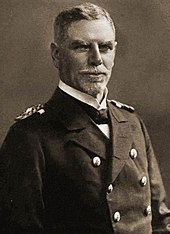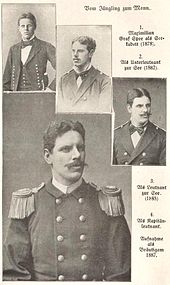Maximilian von Spee
Maximilian Johannes Maria Hubert Reichsgraf von Spee (born June 22, 1861 in Copenhagen , † December 8, 1914 in the South Atlantic ) was a German naval officer in the Imperial Navy . Four months after the start of the First World War , he was killed with his two sons on the Scharnhorst in a sea battle near the Falkland Islands .
Life
Spee's military career began on April 23, 1878 when he joined the Imperial Navy as a cadet . In 1884/85 he served as a sea lieutenant in the West African cruiser squadron (see also German West Africa ). Since 1887 port commander in Cameroon , he had to return home because of severe rheumatoid arthritis and was released for convalescence leave. Healthy again, he drove on the Moltke . On the Germany he came to China in the East Asia Squadron . There he served as first officer on the battleship Brandenburg with the rank of corvette captain . After the Boxer Rebellion was put down (Beijing fell in August 1900), he returned to the Reich, and on January 27, 1905, he was appointed captain at sea and in command of the Wittelsbach . On the day five years later to Rear Admiral promoted, he was the Second Admiral the reconnaissance ships of the High Seas Fleet . From 1908 to 1910 he was Chief of Staff at the North Sea Naval Station. As a flag officer , he was given command of the East Asia Squadron on December 4, 1912 .
The ships - Scharnhorst , Gneisenau , Leipzig , Nuremberg and Emden - lay in Tsingtau and Simpsonhafen . On November 15, 1913, Spee was promoted to Vice Admiral.
Naval warfare
At the beginning of the First World War , Spee with the flagship Scharnhorst and the Gneisenau was located in Pohnpei , which was then called Ponape - in the middle of the South Pacific , but far away from both bases and the sea routes in the Pacific Ocean . In fear of an attack by the Imperial Japanese Navy on Tsingtau and Australia , the flagship of the new Royal Australian Navy , Spee could only move west into the Indian Ocean or east towards South America . Spee stayed in Pohnpei until August 6, 1914 in contact with Yap via radio telegraphy and from there with Tsingtau via submarine cables . Of Honolulu who joined Nuremberg to the two ships. From August 11th to 13th in Pagan , the association was strengthened by the Emden , Prince Eitel Friedrich and some supply ships . Supplies and especially coal were scarce. In those same days, the radio station on Yap was destroyed, which completely isolated Spee and his ships. On the march to the Marshall Islands , the (now famous) Emden was sent to the Indic , the Nuremberg sent back to Honolulu; she should find the main body of the Royal Navy . The auxiliary cruiser Cormoran joined the formation in the Marshall Islands . Spee learned of the feared entry into the war by Japan (which had joined the Entente on August 16; see also here ). He could only disrupt British sea trade on the west coast of America .
On August 29th, he made his way to Fanning Island to meet the Nürnberg . Cormoran and Prince Eitel Friedrich were released. The Scharnhorst ran via German Samoa and Tahiti to the Marquesas , where they could stock up on provisions. On the march to Easter Island on October 3, radio communication with the Leipzig and Dresden was established. Spee ordered them to Easter Island, where his squadron's ships met.
Coronel
The next day the radio traffic was tapped from the British station in Fiji . The British Admiralty then ordered Christopher Cradock to pull together his squadron off the coast of Chile . Spee's association marched via Más Afuera to Valparaíso , but remained out of sight. The Glasgow had listened to the Leipzig radio messages on October 31 and was already in Valparaíso. The next day at around 4 p.m. the battle in front of Coronel began .
By cleverly exploiting the light, wind and sea conditions and using their more modern equipment, the Germans succeeded within three hours in sinking the two British armored cruisers and forcing the damaged ships Glasgow and Otranto to flee.
Good Hope and Monmouth sank with 1,600 men and Admiral Cradock; this surprised and shocked the British Admiralty and the public. The Admiralty sent Frederik Doveton Sturdee with the battlecruisers Invincible and Inflexible on the hunt for Spee. It ran into Valparaíso, stashed coal on Más Afuera and moved via Valparaíso to the Gulf of Penas . After taking over coal from four German freighters there, he lifted anchor on November 26th.
Falklands
After the bandage at midnight from 1/2. December had rounded Cape Horn , Spee brought up an English barque . In Picton , their coal cargo was loaded onto the German ships. This three-day delay proved fateful; because when Spee decided to attack the radio and coal station in Port Stanley on December 8, 1914, despite the reservations expressed by his staff officers , the Canopus was no longer alone in the port. Sturdee had arrived the day before with his two battlecruisers. When Spee reached the Falkland Islands , the Canopus' artillery opened fire. Spee tried in vain to escape to the east. Scharnhorst , Gneisenau , Leipzig and Nuremberg were sunk. Over 2,200 German marines were killed. His two sons Otto (* 1890) and Heinrich (* 1893) died with the squadron chief.
family
Spee was born as the fourth son of Count Rudolf von Spee (1822–1881) and his wife Fernanda Maria Sophie née. Tutein (1832–1913) born. He was the grandson of Count Franz Anton von Spee (1781-1839) and great-grandson of the Italian opera singer Giuseppe Siboni (1780-1839). The electoral Palatinate ministers Franz Wilhelm Caspar von Hillesheim (1663–1748) and Franz Karl Joseph Anton von Hompesch zu Bolheim (1735–1800), as well as the electoral Palatinate chief hunter Ludwig Anton von Hacke (1682–1752) are also among his ancestors.
Maximilian von Spee was married to Margareta born in 1889. Freiin von der Osten-Sacken (1867–1929), with whom he had two sons and daughter Huberta (1894–1954).
Honors
Ship names
Three warships were later named after Graf von Spee :
- The outpost boat Graf Spee of the Imperial Navy
- Graf Spee - Great cruiser of the Mackensen class of the Imperial Navy, launched September 15, 1917 - the ship remained unfinished
- Admiral Graf Spee - Germany- class armored ship ofthe Reichsmarine , launched on June 30, 1934 - scuttled on December 17, 1939
- Graf Spee - school frigate (1959–1967) of the German Navy
monument
- Punta Arenas Cemetery , Chile
- Kiel : memorial plaque for Spee and the sons at the St. Heinrichs Church , the Catholic garrison church . Hidden behind bushes and neglected for decades, the marble mourning relief with Spee's portrait on the right outer wall of the entrance can only be found with care.
Street names
- Aurich
- Berlin-Tiergarten : from 1935 to 1989 today's Hiroshimastraße was named after him at the Reichsmarineamt
- Bremen - Hastedt
- Düsseldorf : Speestrasse
- Dortmund ; In 2014, the city archives issued a statement in favor of renaming Speestrasse.
- Food : school and street in Bredeney
- Freiburg im Breisgau : Admiral-Spee-Straße in the Wiehre district
- Kiel : Graf-Spee-Straße in the Blücherplatz district (since 1936)
- Königsberg (Prussia) : Graf-Spee-Straße in Amalienau
- Munich-Trudering : Graf-Spee-Platz
- Münster : Street in St. Mauritz
- Oldenburg (Oldenburg) : Street in Donnerschwee
- regensburg
- Trier : Speestrasse
- Westerland : Street in the former naval settlement
- Fulda : Graf-Spee-Strasse
literature
- Siegfried Breyer: Capital ships 1905-1970 . Bernard & Graefe, Koblenz 1990, ISBN 3-7637-5877-1 .
- Gerhard Koop, Klaus-Peter Schmolke: The armored ships of the Germany class . Bernard & Graefe, Bonn 1993, ISBN 3-7637-5919-0 .
- Gerhard Koop, Klaus-Peter Schmolke: The big cruisers From the Tann to Hindenburg . Bernard & Graefe, Bonn 1998, ISBN 3-7637-5972-7 .
- Joachim Lietzmann : At a losing position. Under the flag of Count Spee in 1923, new editions in 1933 and 1936
- Werner Rahn : Spee, Maximilian Johannes Maria Hubert Reichsgraf von. In: New German Biography (NDB). Volume 24, Duncker & Humblot, Berlin 2010, ISBN 978-3-428-11205-0 , p. 643 f. ( Digitized version ).
- Gerhard Wiechmann (ed.): From foreign service in Mexico to the sea battle of Coronel. Captain Karl von Schönberg. Travel diary 1913–1914 . Dr. Winkler Verlag, Bochum 2004, ISBN 3-89911-036-6 .
- Erich Gröner u. a .: The German warships 1815-1945 , Vol. 8/2: Outpost boats, auxiliary minesweepers, coastal protection associations (part 2), small combat associations, dinghies , Koblenz (Bernard & Graefe) 1993, p. 533. ISBN 3-7637-4807-5
Web links
- Gallery of the German Federal Archives on the sea battle at Coronel
- Exhibition at the Google Cultural Institute on the sea battle at Coronel
- "The Downfall of the East Asia Squadron" by Jürgen Ritter at Spiegel Online
- Newspaper article about Maximilian von Spee in the 20th century press kit of the ZBW - Leibniz Information Center for Economics .
Footnotes
- ↑ a b c marine.de
- ↑ a b c d e J. Rickard: Maximilian Reichsgraf von Spee, 1861-1914, German Admiral. (2007).
- ↑ Michael Lorenz : "Many believed and still believe, deliberately." - The death of Ludovica Siboni. In: Schubert through the glasses 23, Schneider, Tutzing 1999, pp. 47–74.
- ↑ PDF document on the history of the Count families von Hillesheim and von Spee
- ^ Yearbooks for Prussian Legislation, Jurisprudence and Legal Administration. Volume 47, Berlin, 1836, pp. 247 and 248; (Digital scan to Spee and von Hacke)
- ^ Graf-Spee-Strasse . In: Street name lexicon of the Luisenstädtischer Bildungsverein
- ↑ cbgnetwork.org
- ↑ Hans-G. Hilscher, Dietrich Bleihöfer: Graf-Spee-Strasse. In: Kiel Street Lexicon. Continued since 2005 by the Office for Building Regulations, Surveying and Geoinformation of the State Capital Kiel, as of February 2017 ( kiel.de ).
| personal data | |
|---|---|
| SURNAME | Spee, Maximilian von |
| ALTERNATIVE NAMES | Spee, Maximilian Johannes Maria Hubert Reichsgraf von |
| BRIEF DESCRIPTION | German admiral of the Imperial Navy |
| DATE OF BIRTH | June 22, 1861 |
| PLACE OF BIRTH | Copenhagen |
| DATE OF DEATH | December 8, 1914 |
| Place of death | South Atlantic off the Falkland Islands |





